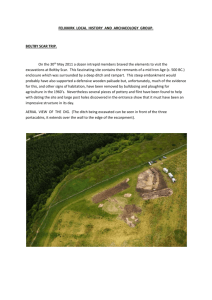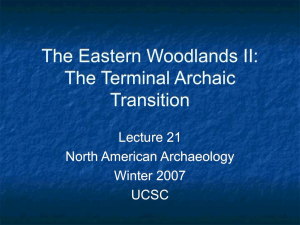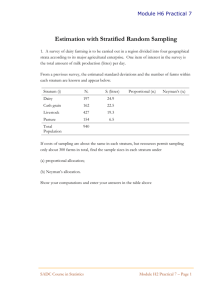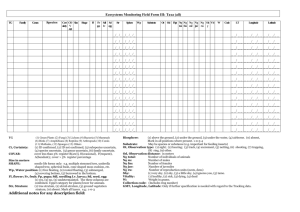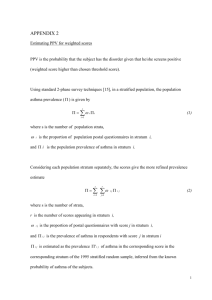Default Normal Template
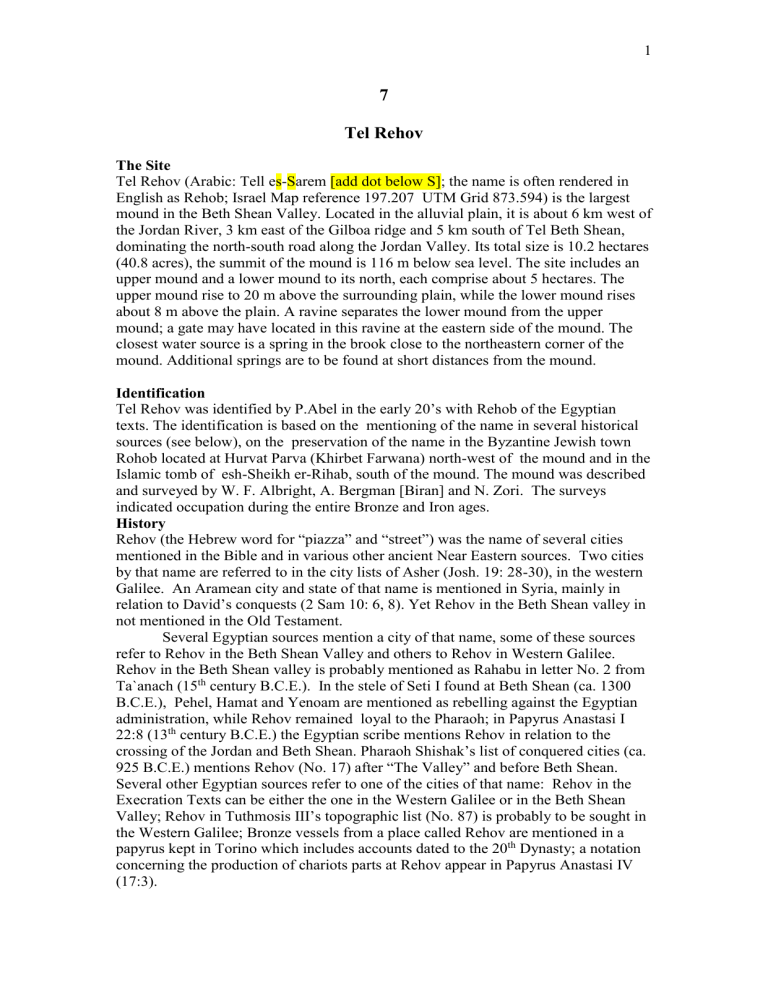
1
7
Tel Rehov
The Site
Tel Rehov (Arabic: Tell es-Sarem [add dot below S]; the name is often rendered in
English as Rehob; Israel Map reference 197.207 UTM Grid 873.594) is the largest mound in the Beth Shean Valley. Located in the alluvial plain, it is about 6 km west of the Jordan River, 3 km east of the Gilboa ridge and 5 km south of Tel Beth Shean, dominating the north-south road along the Jordan Valley. Its total size is 10.2 hectares
(40.8 acres), the summit of the mound is 116 m below sea level. The site includes an upper mound and a lower mound to its north, each comprise about 5 hectares. The upper mound rise to 20 m above the surrounding plain, while the lower mound rises about 8 m above the plain. A ravine separates the lower mound from the upper mound; a gate may have located in this ravine at the eastern side of the mound. The closest water source is a spring in the brook close to the northeastern corner of the mound. Additional springs are to be found at short distances from the mound.
Identification
Tel Rehov was identified by P.Abel in the early 20’s with Rehob of the Egyptian texts. The identification is based on the mentioning of the name in several historical sources (see below), on the preservation of the name in the Byzantine Jewish town
Rohob located at Hurvat Parva (Khirbet Farwana) north-west of the mound and in the
Islamic tomb of esh-Sheikh er-Rihab, south of the mound. The mound was described and surveyed by W. F. Albright, A. Bergman [Biran] and N. Zori. The surveys indicated occupation during the entire Bronze and Iron ages.
History
Rehov (the Hebrew word for “piazza” and “street”) was the name of several cities mentioned in the Bible and in various other ancient Near Eastern sources. Two cities by that name are referred to in the city lists of Asher (Josh. 19: 28-30), in the western
Galilee. An Aramean city and state of that name is mentioned in Syria, mainly in relation to David’s conquests (2 Sam 10: 6, 8). Yet Rehov in the Beth Shean valley in not mentioned in the Old Testament.
Several Egyptian sources mention a city of that name, some of these sources refer to Rehov in the Beth Shean Valley and others to Rehov in Western Galilee.
Rehov in the Beth Shean valley is probably mentioned as Rahabu in letter No. 2 from
Ta`anach (15 th
century B.C.E.). In the stele of Seti I found at Beth Shean (ca. 1300
B.C.E.), Pehel, Hamat and Yenoam are mentioned as rebelling against the Egyptian administration, while Rehov remained loyal to the Pharaoh; in Papyrus Anastasi I
22:8 (13 th
century B.C.E.) the Egyptian scribe mentions Rehov in relation to the crossing of the Jordan and Beth Shean. Pharaoh Shishak’s list of conquered cities (ca.
925 B.C.E.) mentions Rehov (No. 17) after “The Valley” and before Beth Shean.
Several other Egyptian sources refer to one of the cities of that name: Rehov in the
Execration Texts can be either the one in the Western Galilee or in the Beth Shean
Valley; Rehov in Tuthmosis III’s topographic list (No. 87) is probably to be sought in the Western Galilee; Bronze vessels from a place called Rehov are mentioned in a papyrus kept in Torino which includes accounts dated to the 20 th
Dynasty; a notation concerning the production of chariots parts at Rehov appear in Papyrus Anastasi IV
(17:3).
2
The Excavations
The excavations at Tel Rehov, directed by A. Mazar, were conducted on behalf of the Institute of Archaeology of the Hebrew University and sponsored by Mr.
J. Camp. The first five seasons took place between 1997 and 2001. Two excavation areas (A and B) were opened on the upper mound, and five (C, D, E, F, G) on the lower mound. In addition, geophysical surveys and geological research were conducted.
The Early Bronze Period
A narrow trench in the south-western part of the upper mound revealed a fortification system of the EBII-III. This is the only place where this period was reached in the excavation. The system included a 9.5 m wide mudbrick wall that was preserved to a maximum height of 6.5 m. The wall was abutted on its outer side by an earth glacis, preserved 13 m wide and 3.5 m high, and it probably surrounded the upper mound.
This impressive fortification system indicates that Tel Rehov was perhaps the main city in the valley during this period, and perhaps a city state, as it would be in the
Second Millennium B.C.E.
Intermediate Bronze Age
Evidence for Intermediate Bronze Age settlement and cemetery was found in surveys in the alluvial plain west of the mound. Several shaft burial caves from this period were excavated by Yogev for the IAA and by the new expedition in collaboration with the IAA near the south-western corner of the mound. They contained pottery vessels, metal weapons and beads.
The Middle Bronze Period
The excavation did not reach this period. Zori published an Old Babylonian seal from the mound and mentions MB pottery. Such pottery was not revealed by the new expedition.
Late Bronze Period
In Area D, a 5-10 m wide step trench on the western slope of the lower mound, 11 occupation phases were detected, dating from LBI to Iron IIA. The limited exposure of these occupation phases and the severe erosion of the western edges of buildings on the slope limits our knowledge of these periods. Yet the clear stratigraphic sequence is one of the most dense in the entire country relating to the late LB and Iron I periods
(Table 1).
Phase D-11 consists of a layer of dark brown silt and ash, found at the bottom of the trench above travertine bedrock. Its top is about 1.2 m below the level of the present alluvial field to the west of the mound, indicating a significant change of the level of that plain during historical periods. The few pottery sherds found in this layer included some Chocolate on White sherds typical to the end of MBII or the beginning of LB.
Phase D-10 is a layer of light yellow travertine, more than 2 m thick, found at the foot of the mound. In a trial trench excavated 20 m north of Area D, this travertine layer was about 6 m deep. This layer is void of any pottery or other finds, except for one carinated LB bowl. The travertine must have accumulated in a water body - a small lake or pond that existed at the foot of the mound between the late 16 th century and the 13 th
century B.C.E. During this time, water seem to have reached the foot of the mound and the pond could have covered much of the present day field to the west of the site. The discovery of this pond raises questions as to possible tectonic
3 changes which prevented the water from being drained to the northeast, where today there is a brook that drains the plain towards the Jordan river.
In Phase D-9b of the 13 th century B.C.E. a substantial building was founded above the travertine layer. A 1 m wide east-west wall with two subsidiary walls were uncovered. A complete clay plaque figurine of a naked woman with a leonine head (?) was found here. In a later phase (D-9a) a new cobble floor was constructed in this building. No evidence for a violent destruction was found. In Phase D-8, still in the
13 th
century B.C.E., a thick plaster floor covered the remains of the previous building.
A ca. 1 m thick accumulation of fallen mudbicks and debris covered this floor.
Iron Age IA
Phase D-7 in Area D included part of a building in which a floor was detected on which several pottery, stone and faience vessels were found. Two “foundation deposits” of the “bowls and a lamp” type, typical to this period, were related to this building. The local pottery is typical to the first half of 12 th
century B.C.E. though unlike at Beth Shean, Egyptian forms were very rare here. Thick accumulation of fallen brick debris covered this building.
To Phase D6, only disturbed remains could be attributed. They include fragments of flimsy walls and floor surfaces in an open area which were rapidly accumulated, resulting in striations which at one point included 65 horizontal superimposed thin layers. This phase can tentatively be dated to the mid 12 th
century
Iron Age IB
Phases D-5 and D-4 represent two architectural phases of the same city, which was constructed, destroyed and rebuilt during the Iron IB period. In both phases, a north-south and parts of houses on both its sides were excavated in the middle part of the slope in Area D. Phase D-5 ended in destruction creating thick brick debris. In
Phase D-4 the buildings of D-5 were rebuilt. This was a lengthy period, when floor surfaces were raised several times and some architectural changes occurred. A destruction of Phase D4 was followed by a total change in the function of this area: in Phase D-3 it became an open area with many pits. About 50 shallow pits were excavated in a rather small excavation area; some are small and shallow, others are larger and well plastered. They were probably used for storing grain or other products.
The pottery of Phases D5-D3 is typical to the Iron Age Ib in this region: large amount of painted decoration, mostly in dull red on a buff surface. The main designs are horizontal stripes and irregular wavy lines. Few Philistine sherds were found in
Phase D-4. Radiocarbon dates confirm a date in the 11th century B.C.E. for Phase D-4 and late 11 th
/early 10 th
century B.C.E. for Phase D-3.
Area D thus revealed a continuous development of the Canaanite city from the
13 th
to the end of the 11 th
centuries B.C.E., in spite of at least three destructions.
In Area C, local Phase C-3 (general Stratum VII) is parallel to Phase D-3, and date to the end of the Iron Age I, yet only few mudbrick walls floor surfaces from this phase were excavated.
TABLE 1. Stratigraphic Chart of Area D
Phase Main Features
D1 Wall foundations, oven, open space.
(= general Stratum V)
D2 Three thin plastered walls.
Date
Iron IIA (10 th cent.)
11 th
century
4
(=general Stratum VI).
D3 Many pits in an open area
D4 Street flanked by buildings.
Ends in severe destruction.
11 th
century
11 th
century
D5 Two brick walls
D6 Striations, ovens, poor architecture
Late 12 th century?
Mid 12 th century
D7 Room with floor; destruction with thick layer of fallen bricks
Early 12 th
century
D8
D9a
D9b
Plaster floor
Large building, second phase
Large building: first phase
Late 13 th
century
13 th
century
13 th
century
15-14 th
centuries D10 Pond/lake creating deep travertine sediment
D11 Dark brown and black sediments 16-15 th
centuries
The Iron Age IIA
We refer here to the Iron Age IIA as a period starting sometime during the first half of the 10 th
century B.C.E. and ending during the second half of the 9 th
century B.C.E., probably shortly after the end of the Omride Dynasty. This is the main period studied by the expedition in six excavation areas (B-G). Three strata were defined: VI, V and
IV. These strata numbers are based on correlation between local stratigraphic phases in the various areas.
The architecture of this period is exceptional in the Iron Age architecture of
Israel: all the buildings are built of mudbricks without stone foundations; wood foundations for both walls and floors are a common feature, in particular in Stratum V
(in Areas C, B and G). The buildings are well-planned, the town plan appears to be preconceived and regular, with parallel blocks of buildings. However, the buildings cannot be classified typologically and appear to be exceptional in their plans. The typical Israelite pillared buildings of the “four room” or “three room” plan don’t appear at Tel Rehov. No fortifications were found in the lower mound, though the excavation reached the edge of the tell in Areas D, C and E. The rich finds from these three strata (especially from the last two) are typical to a specific regional aspect of the Iron Age IIA in northern Israel. The following is a brief survey of the main structural remains in each of the areas.
Area B (northern slope of the upper city). Stratum VI: only few floors and fragmentary walls belong to this period. Among the finds was an incised inscription on pottery sherd with three letters: lnh[ ], perhaps “belonging to Nah[um]”.
Stratum V: walls of two large buildings were exposed, yet only partly excavated. One excavated room revealed thick destruction layer; the beaten earth floor of this room was founded on wood foundation.
Stratum IV: A double wall system constructed parallel to the slope of the mound appears to be part of a fortification system or of a fortified building. A drain passed through this double wall. In the western side of the area, a massive tower was abutted by this double wall system. Fragments of dwellings and an open courtyard were found to the south of the double wall system.
5
Area C. This is the largest and main area for studying Strata VI-IV. The area is located on the uppermost part of the lower town, near its northwestern corner.
Stratum VI (=Local phase C-2): parts of three buildings were excavated. Building A in the northwestern part of the area includes four rooms: two of medium size and two small chambers; Building B in the central part of the area includes a large hall, well preserved with two openings still intact. Building C in the southern part of the area was only partly excavated. Open spaces and cooking areas were also defined. No evidence for violent destruction of this city was found, yet thick mudbrick debris and cracks in the walls hint to destruction or severe damage which could have been caused by earthquake.
Stratum V (local Phase C1b): The area was rebuilt, retaining some of its earlier town plan features. Building A of the previous city was rebuilt with different inner plan
(now termed Building D). To its south, the area of building B of Stratum VI appears to have been left empty in Stratum V. New buildings were founded in the eastern and southern parts of Area C, representing a considerable change in plan comparing to the previous city. In the northeastern part of the area, two new buildings were detected (E and F) yet only partly excavated. Building F was an elaborate, large structure which was burnt at the end of Stratum V and rebuilt in Stratum IV (see below). In the eastcentral part to the area, Building G is a strange unit composed of three small square chambers without openings. This appears to be a storage building, with chambers entered from an upper level. To its south, Building H, which was only partly excavated, was a spacious building with what appears to be a basement with wooden roof, which served as the floor of the first story. In the south and western parts of Area
C, parts of additional buildings were revealed. Both Buildings G and H were destroyed in heavy fire; the wooden roof of the basement in Building L collapsed to the south-east; large amount of restorable pottery vessels and other objects were found in the destruction, including vessels used in local cult: a unique horned pottery altar decorated with figures of two naked females on both sides of a tree, an elaborately painted petals chalice and additional. The full plan and function of this building are still enigmatic.
In Stratum IV (Local phase C1a) new buildings were erected and others were renovated. The central part of Area C was a large open courtyard or piazza with a floor and installations found just below topsoil. Building F, in the northeastern part of the area, was rebuilt after a destruction at the end of Stratum V. It is a well preserved, large and well planned building, yet only five of its rooms were excavated so far. Two of these were large rooms with well plastered walls and three were small chambers arranged one behind the other, with benches along their walls. In a thick burnt destruction layer rich finds were revealed, including rich pottery assemblage, a pottery model shrine with unique molded decoration of a crouching animal (lion?) with its front paws on two human heads, a large pottery box, and Greek Middle Geometric cup. One “hipo” jar from this building carried an incised inscription: lšq[?] nmš ; the name Nimshi is known also from a contemporary inscription at Tel `Amal and is known in the bible as the name of Jehu’s father or grandfather.
This large building the residence of high ranking family.
Building L, in the south-eastern part of Area C, replaced the destroyed building H of Stratum V, yet had a totally different plan. This building too was destroyed in conflagration.
Remains of houses destroyed by erosion in Area D phases D1 and D2 can be related to Strata VI and V in Area C; they indicate that these cities had no
6 fortifications, since it is not plausible that entire fortification system and parts of houses inside such a system would completely disappear due to erosion.
Area E. In this area, at the north-eastern corner of the mound, an open air sanctuary was identified. It is known mainly in its last form in Stratum IV, though it appears that it started to exist in Stratum V. Very few remains of Stratum VI were excavated in this area, yet they included typical red slipped and unburnished vessels. The sanctuary included a spacious open piazza, in which floor surfaces were accumulated during long time, probably the time length of both Strata V and IV. Several installations were found in this courtyard, including circular clay bins, ovens, and benches. The courtyard was limited on the north by brick walls, and on the south by two structures with wide passage or open area between them. The western structure included a main hall and two large rooms on both its sides. In one of the rooms mud plaster was decorated with seal impressions showing the motif of volutes and lotus buds and flowers in Phoenician style. Inserted into the north-eastern corner of this building was a platform made of mudbricks on which was a smaller stone platform, unto which were embedded three standing stones which, though not large and unworked, appear to serve as standing stones (masseboth). These stones and the platform face the open courtyard to their north. A large flat stone in front of the platform probably served as an offering table. A discarded broken pottery altar found near the platform probably served in the local cult. It was square in shape and had two rows of triangular windows and perhaps had horned cornice like the complete altar from Area C. The eastern building was probably an auxiliary building: it had several plastered compartments used to store food supplies, and a room where many pottery vessels, included several chalices, were found. Among the finds in the courtyard was an elaborately painted Phoenician showing geometric designs in red, black and white, including guilloche motif and rosettes. This was probably an expensive imported item, offered in this sacred place. One of the jars in the building next to the platform was inscribed with a broken inscription; the preserved letters m’..’m are difficult to explanation.
It appears that this complex was a high place (bamah) perhaps serving the neighborhood. The masseboth could represent either several deities, or, more plausible, ancestors of a local clan. In such a case the entire sanctuary may be related to ancestors cult.
In the western edge of Area E, part of a dwelling of Stratum IV was excavated.
It included a courtyard with cooking facilities and parts of room around it. Here, too, a large collection of pottery was found in a destruction layer just below topsoil.
Area F, to the south of Area E, provided additional data on stratigraphy and town planning. Four architectural construction phases were defined here, all dated to the Iron Age IIa. The walls are parallel to those in nearby Area E, suggesting a well organized town planning with defined blocks of buildings.
In Area G, located south of Area C near the western slope of the mound, parts of additional dwellings of Strata V-IV were excavated. Remains of houses of Stratum
IV (local phase G-1) were found close to topsoil, including rich assemblages of pottery and other artifacts on floors. In the earlier Stratum V (local phase G-2), remains of wood foundation for floors resemble those in Areas C and B. Circular installation made of unfired clay were used for food storage.
7
The large amount of pottery and other artifacts retrieved in Strata VI-IV contribute much new data on the material culture of the 10-9 th
centuries in northern
Israel. The pottery of all three strata is very similar, and in all red slip and hand burnish are common. Yet some distinctions between these strata can be made; thus in
Stratum VI there are also vessels with pale red slip with no burnish. Storage jars of the
“Hippo” type are common in Strata V and IV, but not in VI. Thin delicate bowls with burnished red slip start to appear in Stratum IV. Rough painting in red paint
(specially on closed vessels) still appears. The best parallels to the assemblage are to be found at Megiddo Strata VB and VA-IVB, Ta`anach Periods IIA and IIB, Hurvat
Rosh Zayit Strata 3-2, Tel `Amal, Tell el Hammeh and Jezreel.
Imported pottery in Strata V and IV include Phoenician Bichrome, Cypriote
Black on Red I(III), White Painted and Bichrome vessels. Notably, several Greek sherds are found, including Proto-Geometric Euboean pyxis in Stratum V and Middle
Geometric Attic cups in Stratum IV.
Strata VI-IV yielded a variety of seals and cult objects. The Pyramidal and scaraboid shaped seals and seal impressions from Strata VI-IV are of typical style: they depict variety of animals (horned animals, ostriches, crab, birds); impressions of rectangular seals show schematic human figures (or deities?) striding on top of mountains(?); in two cases there are two figures of this type in tete-beche composition. These latter seals are known only from the Beth Shean valley. A unique ivory object from Stratum IV is a three dimensional depiction of a human figure dressed with a long garment, sitting on a throne (only part of the body and throne were preserved).
Pottery horned altars were common: in addition to the two complete examples mentioned above there were additional fragments, and it appears that this type of altar made was common in this region, with parallels at Pella. It retains traditions known from Syria at the end of the Late Bronze Age. The clay figurines belong to
Canaanite/Phoenician artistic tradition. One unique figurine in a local rude style shows a naked female probably crouching on her knees. Others are typical to northern
Israel, like two examples of the “drum player” woman and female heads.
Radiocarbon dates from strata V and IV indicate that the former city was destroyed during the second half of the 10 th century, while the latter during the 9 th century, yet no later than 830 B.C.E. It is tempting to relate the destruction of Stratum
V to the invasion of Shishak and that of Stratum IV to the Aramean wars, probably those after the end of the Omride Dyansty.
The Iron IIB period
Stratum III
Following the destruction of Stratum IV, the lower city was abandoned and never settled again. During the Iron IIb period (ca. 830 - 732 B.C.E.) the city was reduced to half its former size and was limited to the upper mound (Stratum III).
In Area B dwellings of Stratum IV were rebuilt and floors raised. Yet the northern edges of these houses were now cut by the foundation of a new city wall. This was a
9.5 m wide offsets and insets wall, built of bricks without stone foundation. It covered the former double wall system of Stratum IV, yet incorporated the former tower of
Stratum IV at the western part of the area. This was probably a very tall wall, and its destruction caused enormous fall of brick material to the north, towards the lower city.
8
The wall was probably intended to defend the city against the threat of Assyrian battering rams. It probably collapsed after the Assyrian conquest of the city, most probably in 732 B.C.E.
Remains of Stratum III houses were uncovered in Area A (central part of the upper mound). Three stratigraphic phases of the Iron Age II were found here preceding the
Assyrian conquest (local phases A6- A4). The last terminated in violent destruction layer, I which two human skeletons were found in side rooms, unburied. One of these was decapitated, found on top of a heap of loom weights. This appears to be evidence of slaughtering of people in their houses, most probably during the Assyrian conquest.
The pottery on the floors of the houses of Stratum III is typical to the 8 th century B.C.E.
Stratum II
Two graves found in Areas A and B contained remains of human bodies in crouched position, with one Assyrian pottery bottle near the head of each. These could be graves of Assyrian soldiers or officials, buried on in the ruins of the city. Few floors and installations are evidence for squatters which existed for a short time on top of the ruined city. These were followed by a total break in occupation.
The Early Arab to Medieval periods: Stratum I.
A small settlement (village?) existed on the mound between the 8 th and 12 th centuries C.E. The remains found in Areas A and B seem to be related to the edges of this settlement. These included few floor surfaces, very poor architectural remains and mainly eroded refuse layers, perhaps evidence of garbage disposed outside the settlement which stood on the summit of the mound. These layers were up to 1 m deep at several places.
Several Islamic graves were found in Areas B and E. These lacked any finds and their date remains obscure.
Summary
The first five seasons of excavations at Tel Rehov indicate that this was the main
Bronze and Iron Age site in the Beth Shean valley and in Israel, and one of the largest in the entire country. The history of the place in the Bronze Age is till vague, except the Early Bronze Age fortification system which is one of the most immense in the country. The results of the work in the Lower City indicate occupation at the end of the Middle Bronze Age, and in the 13 th
century B.C.E.; other Bronze Age strata may still be hidden in both the lower and the upper mounds. The excavation in the Lower
City indicate continuous urban settlement throughout the 13 th
-9 th
centuries B.C.E., in spite of a number of destructions. The Canaanite character of the material culture was maintained until the end of the Iron Age I, and it appears that the inhabitants were local Canaanites. Strata VI-IV of the Iron Age IIA signify the development of the city during the early Israelite Monarchy, until after the end of the Omride Dynasty. This period must have lasted through most of the 10th and 9 th
centuries B.C.E. A conflagration which destroyed parts of Stratum V may indicate a conquest by Shishak, while the violent end of Stratum IV and abandonment of the Lower City may be related to one of the events in the mid 9th century B.C.E., probably the Aramean wars after the end of the Omride Dynasty. The two last Iron IIA cities (Strata V-IV) were prosperous; trade relations with Phoenicia, Cyprus and Greece existed. Variety of cult objects, seals, ivory objects etc. indicate that Canaanite/Phoenician and northern
9
Syrian traditions were retained by the local population. Much of this population could be descendents of the previous Iron I Canaanites, though now the city was part of the
Israelite kingdom.
During the late 9 th
and 8 th
centuries (Stratum III) the city was restricted to an area of 5 hectares on the upper mound and was surrounded by immense fortification wall. This city survived until the Assyrian conquest of 732 B.C.E., which is dramatically documented by total destruction and the evidence for slaughter in the houses. Two graves with Assyrian pottery and few additional remains (Stratum II) are indications for a short period of activity after the Assyrian conquest, but soon the site was abandoned.
In the early Arab period a small village existed on the summit of the upper mound; it continued to exist until the Medieval period.
Bibliography
A.Mazar, The 1997-1998 Excavations at Tel Rehov: Preliminary Report. IEJ 49
(1999) pp. 1-42.
A.Mazar, Three 10th-9th Century B.C.E. Inscriptions from Tel Rehov, pp. 171-184 in: C.G. den Hertog, U.Hübner and S.Münger (eds.), Saxa loquentur. Studien zur
Archäologie Palästinas/Israels.Festschrift für Volkmar Fritz zum 65. Geburtstag
(Alter Orient und Altes Testament 302), Münster.
A.Mazar and J.Camp, Biblical Archaeology Review 26:2 (2000) pp.38-51.
A.Mazar and I.Carmi, Radiocarbon Dates from Iron Age Strata at Tel Beth Shean and
Tel Rehov. Radiocarbon 43:3 (2001) pp. 1333-1342.
A.Mazar and N.Coldstream, Greek Pottery from Tel Rehov and Iron Age Chronology IEJ
53 (2003) PP. 00-00.
N.Zori, An Archaeological Survey of the Beth Shean Valley, in: The Beth Shean
Valley, The 17 th Archaeological Convention, Jerusalem 1962, p.176-178 (in Hebrew).
Zilberman, E., Bruner, I., Amit, R. and Land, Y. The Subsurface of Tel Rehov, Biq’at
Bet She`an. GSI Current Research 13 (2002), 9-18.
4700 words without bibliography
A B
Excavation Area
C D E F
1
2
3a
3b
4
1
2
3
4
5a
5b
6
-
-
-
1a
1b
2
3
-
-
-
-
-
1-2
1a
1b
2
6
7
8
9a
9b
10
4
5
3
11
Tel Rehov: Stratigraphic Table
1
2
3
4
1
2
G
3
4
Final
Strat um
Period
I Early
Islamic
II Iron Age
IIC
III Iron Age
IIB
IV
V
VI
Iron Age
IIA
VII
Iron Age
IB
Dates
8-12 cent. CE
Assyrian
Ca. 930- 732
B.C.E.
Ca. 980 (?) - 830
(?) B.C.E.
Ca. 1150 B.C.E. –
980 (?) B.C.E.
Iron Age
IA
Late
Bronze IIB
Ca. 1200-1150
B.C.E
13 th century B.C.E.
Late
Bronze
I-IIA
MB/LBI
15-14 th cent.
B.C.E.
16 th cent. B.C.E.
10
